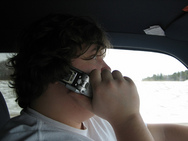A major NTSB safety recommendation remains forgotten

Photo by bjosefowicz on Flickr.
After the fatal Metro crash at Fort Totten, state, local, and federal agencies all agreed that Metro must comply with the recommendations of the National Transportation Safety Board at all cost. Metro is now spending well over a billion dollars to satisfy NTSB point by point.
Yet our region’s transportation system is ignoring one NTSB recommendation — even though it would cost no money while saving more lives than any of the ongoing rail safety upgrades.
Last December, the federal agency recommended a complete ban on the use of portable electronic devices such as cell phones (hand-held and no-hands alike) while driving. Yet none of the jurisdictions in the WMATA compact area has taken any action to comply.
While the safety problems on Metrorail that came to light at Metro after the 2009 crash are very real, by far the most dangerous part of a Metro rider’s journey is the walk to the station or bus stop. A total of 854 pedestrians were killed by drivers of motor vehicles in the Washington area between 2001 and 2009.
There are no statistics on how many of the 854 pedestrian deaths cellphone use contributed to, but anyone who watches drivers at busy intersections knows that it has to be a significant fraction. For Metrorail, the eight passengers who died in the Fort Totten accident were the only fatalities in this period.
Implementing this NTSB recommendation is mainly up to the two state legislatures and the DC Council. But Metro itself can lead the way. Under Article 76(e) of the WMATA compact, Metro’s board can adopt regulations for traffic on Metro’s facilities. Metro should act on its own to ban cellphone use by drivers of moving vehicles in garages, kiss-and-rides and other Metro property.
Drivers will be inconvenienced if they must stop their cars to use a cellphone. But weekend service interruptions caused by safety upgrades are already a major hassle for Metro riders. Local governments have decided that is a price that has to be paid for passenger safety. If inconvenience to transit riders is no reason to ignore the NTSB, neither is inconvenience to drivers.
